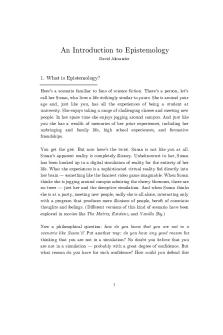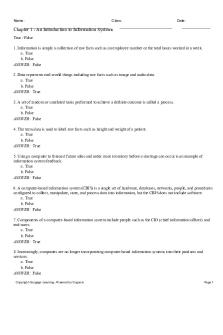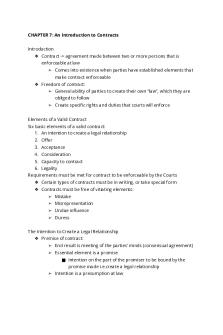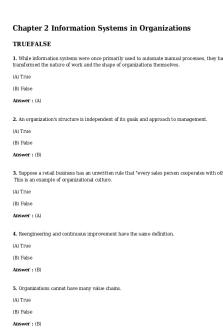Chapter 1 - Steven McCornack & Kelly Morrison, 2019. Reflect & relate: An introduction to PDF

| Title | Chapter 1 - Steven McCornack & Kelly Morrison, 2019. Reflect & relate: An introduction to |
|---|---|
| Course | Introduction To Interpersonal Communication |
| Institution | University of Wisconsin-Madison |
| Pages | 6 |
| File Size | 172.5 KB |
| File Type | |
| Total Downloads | 30 |
| Total Views | 162 |
Summary
Steven McCornack & Kelly Morrison, 2019. Reflect & relate: An introduction to interpersonal communication (5th Edition). Boston: Bedford/St. Martin’s....
Description
What is communication? Although people often think of communication skills as “just intuition,” it’s actually anything but. We all come to communication classes with a lifetime of hands- on experience communicating, and we bring with us different skill sets and abilities. - But personal experience isn’t the same as systematic training. We define communication as the process through which people create messages, using a variety of modalities and sensory channels to convey meanings within and across contexts. - Communication is a process that unfolds over time through a series of actions that connect the participants. - Create messages to convey meanings. A message is the “package” of information that is transported during communication. When people exchange a series of messages, the result is called an interaction - To convey meanings, communicators choose from many different modalities—or forms —for exchanging messages. - People transmit information through various sensory channels when communicating. Sensory channels include auditory (sound), visual (sight), tactile (touch), olfactory (scent), or oral (taste). - Communicators convey meanings within and across a seemingly end- less assortment of contexts, or situations. Linear Communication Model - communication is an activity in which information flows in one direction, from a starting point to an end point - message and a channel, there must be a sender (or senders) of the message—the individual(s) who generates the information to be communicated, packages it into a message, and chooses the channel(s) for sending it. - it. But the transmission of the message may be hindered by noise —environmental factors that may impede mes- sages from reaching their destination. Noise includes anything that causes our at- tention to drift, such as poor reception during a cell- phone call or the smell of fresh coffee nearby. Lastly, there must be a receiver —the person for whom a message is intended and to whom the message is delivered. Interactive Communication Model - also views communication as a process involving senders and receivers. However, according to this model, transmission is influenced by two additional factors: feedback and fields of experience. Feedback is composed of the verbal and nonverbal messages (such as eye contact, utterances such as “Uh- huh,” and nodding) that recipients convey to indicate their reaction to communication. Fields of experience consist of the beliefs, attitudes, values, and experiences that each participant brings to a communication event. People with similar fields of experience are more likely to understand each other compared to individuals who lack these commonalities. transactional Communication model
-
The transactional communication model suggests that communication is fundamentally multidirec- tional. That is, each participant equally influences the communication behavior of the other participants . From the transactional perspec- tive, there are no “senders” or “receivers.” Instead, all the parties constantly exchange verbal and nonverbal messages and feedback, and collaboratively create meanings.
Interpersonal communication - One answer is that knowledge of interpersonal skills is essential for main- taining healthy interpersonal relationships. - definition: interpersonal communication is a dynamic form of communication between two (or more) people in which the messages exchanged significantly influence their thoughts, emotions, behaviors, and rela- tionships. - it’s dynamic rather than static. - is transactional, - communication is primarily dyadic—it involves pairs of people, or dyads. - to distinguish it from intrapersonal communication— communication involving only one person, in the form of talking out loud to your- self or having a mental “conversation” inside your own head. - perhaps most importantly, interpersonal communication creates impact: it changes participants’ thoughts, emotions, behaviors, and relationships. The impact on relationships is one of the most profound and unique effects created through interpersonal communication, and it stands in sharp contrast to impersonal communication—exchanges that have a negligible perceived impact on our thoughts, emotions, behaviors, and relationships. When we do so, using our interper- sonal communication skills to reduce distance and orient to the “whole being” of others, we come to perceive them and our relationship as I- Thou. As a consequence, we increasingly perceive our relationships as I- It: we regard other people as “objects which we observe, that are there for our use and exploitation”\ Highlighting the mental, emotional, behavioral, and relational impact of inter- personal communication reinforces the central theme of this text: the communication choices we make determine the personal, interpersonal, and relationship outcomes that follow.
Interpersonal Communication Conveys Both Content and Relationship Information - Relationship information indicates how each person views the relationship: whether you consider yourself superior, equal, or inferior to the other person and whether you see the relationship as casual, intimate, or estranged. Because relationship information influences how people interpret content information, it can be considered a specific form of meta- communication—com- munication about communication - includes any message, verbal or nonverbal, that centrally focuses on how the meaning of communication should be interpreted—everything from discussion of previous comments consequence, interpersonal communication isn’t trivial or incidental; it fulfills a profound human need for connection that we all possess. Once physical needs are met, we concern ourselves with safety needs—such as job stability and protection from violence. Then we seek to address social needs: forming satisfying and healthy emotional bonds with others. Next are self- esteem needs, the desire to have others’ respect and admiration. We fulfill these needs by contributing something of value to the world. Finally, we strive to satisfy self- actualization needs by articulating our unique abilities and giving our best in our work, family, and personal life. first—self- presentation goals— are desires you have to present yourself in certain ways so that others perceive you as being a particular type of person. have instrumental goals—practical aims you want to achieve or tasks you want to accomplish through a particular interpersonal encounter. achieve relationship goals— building, maintaining, or terminating bonds with others. Beyond the motives and needs that compel us, and the specific goals for which we strive, lies an overarching aspiration regarding our interpersonal communica- tion: the desire to be competent. Interpersonal communication competence means consistently communicating in ways that are appropriate (your communication follows accepted norms), effective (your communication enables you to achieve your goals), and ethical (your commu- nication treats people fairly; into communication skills—repeatable goal- directed behaviors and behavioral patterns that you rou- tinely practice in your interpersonal encounters and relationships Appropriateness The first characteristic of competent interpersonal communica- tion is appropriateness—the degree to which your communication matches situational, relational, and cultural expectations regarding how people should commu- nicate. We judge how appropriate our communication is through self-monitoring: the process of
observing our own communication and the norms of the situation in order to make appropriate communication choices. One of the most important choices you make related to appropriateness is when to use mobile devices and when to put them away This is not a casual choice: research documents that simply having cell phones out on a table— but not using them—during face- to- face conversations significantly reduces perceptions of relationship quality, trust, and empathy compared to having conversations with no phones present effectiveness The second characteristic of competent interpersonal commu- nication is effectiveness : the ability to use communication to accomplish the three types of interpersonal goals discussed earlier (self- presentation, instrumen- tal, and relationship). The final defining characteristic of competent interpersonal communica- tion is ethics —the set of moral principles that guide our behavior toward others
text, we define culture broadly and inclusively as an established, coherent set of beliefs, attitudes, values, and practices shared by a large group of people One way to define gender is as the social, psychological, and cultural traits generally associated with one sex or the other a sexual orientation: an enduring emotional, roman- tic, sexual, or affectionate attraction to others that exists along a continuum ranging from exclusive homosexuality to exclusive heterosexuality, and that includes various forms of bisexuality Our abil- ity to communicate easily and frequently, even when separated by geographic distance, is further enhanced through online communication. The greatest challenges to your interpersonal communication skills lie not in communicating competently when it is easy to do so, but in practicing competent interpersonal communication
when doing so is difficult
What Is Communication? ● The message is the basic unit of communication . We exchange messages during interactions with others, contexts shape how we create and interpret messages, and messages are conveyed through a variety of modalities. ● The linear communication model describes the components necessary for communication to occur. senders communicate messages to receivers that may be misinterpreted due to noise . The interactive communication model adds feedback and fields of experience . The transactional communication model presents the notion that communication participants collaboratively create meaning. What Is Interpersonal Communication? ● Dyadic communication allows us to distinguish interpersonal communication from intrapersonal communication . ● Interpersonal communication changes, and is changed by, participants’ emotions, thoughts, behavior, and relationships. ● Interpersonal communication is characterized by four principles: it has content and relationship information, it can be intentional or unintentional, it’s irreversible, and it’s dynamic. It can be used for fulfilling a hierarchy of needs and pursuing self- presentation, instrumental, and relationship goals What Is Interpersonal Communication Competence? ● People use self- monitoring to observe and judge the appropriateness of their communication as it relates to norms. ● People who demonstrate appropriateness, effectiveness, and ethics in achieving their interpersonal goals are interpersonally competent. ● For competent online communication, choose your medium wisely, don’t assume online communication is always more efficient, presume your posts are public, remember that your posts are permanent, and practice the art of creating drafts. Issues in Interpersonal Communication ● Relevant topics include culture, gender and sexual orientation, online communication, and the dark side of interpersonal relationships....
Similar Free PDFs

1. An Introduction to Epistemology
- 10 Pages

1. An Introduction to Glaciers
- 6 Pages

An introduction to Psychology
- 4 Pages

An introduction to sociolinguistics
- 451 Pages

Chapter 1 - Introduction to Finance
- 26 Pages

Chapter 1 Introduction to Statistics
- 17 Pages
Popular Institutions
- Tinajero National High School - Annex
- Politeknik Caltex Riau
- Yokohama City University
- SGT University
- University of Al-Qadisiyah
- Divine Word College of Vigan
- Techniek College Rotterdam
- Universidade de Santiago
- Universiti Teknologi MARA Cawangan Johor Kampus Pasir Gudang
- Poltekkes Kemenkes Yogyakarta
- Baguio City National High School
- Colegio san marcos
- preparatoria uno
- Centro de Bachillerato Tecnológico Industrial y de Servicios No. 107
- Dalian Maritime University
- Quang Trung Secondary School
- Colegio Tecnológico en Informática
- Corporación Regional de Educación Superior
- Grupo CEDVA
- Dar Al Uloom University
- Centro de Estudios Preuniversitarios de la Universidad Nacional de Ingeniería
- 上智大学
- Aakash International School, Nuna Majara
- San Felipe Neri Catholic School
- Kang Chiao International School - New Taipei City
- Misamis Occidental National High School
- Institución Educativa Escuela Normal Juan Ladrilleros
- Kolehiyo ng Pantukan
- Batanes State College
- Instituto Continental
- Sekolah Menengah Kejuruan Kesehatan Kaltara (Tarakan)
- Colegio de La Inmaculada Concepcion - Cebu









